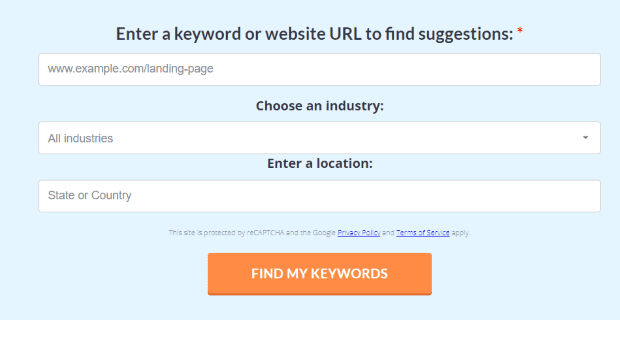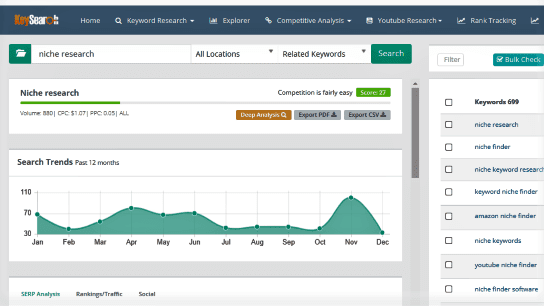
A niche finder tool is like having a secret weapon in your blogging arsenal. Granted it’s not a magical solution.
However, this powerful piece of software is your key to unlocking exploding topics and gaining valuable insights to help you pick the right blog niche.
Before you start an amateur blog, it is essential to identify a niche that aligns with your interests. And you also need to find a niche that has the potential to generate some income.
This is where niche finder tools come in handy. In this blog post, we will explore how to use a niche keyword finders to help you spot profitable niches.
But before we take a closer look at how to leverage the power of a niche finder, let’s understand what makes a niche profitable.
What Is A Blogs’ Niche?
A blog niche is a specific topic or area that that is the focus of your blog. And a profitable niche has a few key characteristics.
First: It has a target audience that is large enough to attract significant traffic, yet specific enough to have a dedicated following.
Second: A profitable niche offers opportunities for making money. Monitization can be through various income streams, such as advertising, affiliate marketing, or selling digital products.
Disclosure: This website contains affiliate links. It means if you buy something after clicking on a link, I may receive a small commission at no extra cost to you. Thank you for your generosity!
How to Use Niche Tools
- Define your blog’s purpose and target audience: Clearly state the purpose of your blog and identify your target audience. Understanding who you’re writing for will help you narrow down potential niche ideas.
- Explore niche ideas and trends: Use the niche tool to explore different niche ideas. Look for exploding topics that match your interests and passions and their growth potential.
- Analyze competition : Determine level of competition within your chosen niche. Niche keyword finders can provide valuable information about competitors websites, their traffic, and ranking.
- Evaluate monetization potential: Use the tool to gather data on potential revenue streams within your choosen niche. Research the monetization potential to ensure it lines up with your goals.
- Choose a niche based on research: Based on the information you gathered through using the niche keyword research, narrow down your options.
- Choose A Profitable Niche: Pick a Niche based on the data you gathered. Your choice should be detrmined by your interests, growth potential, and monetization opportunities of your choosen niche.
Exploring Niche Finders
There are several popular niche finder tools available that can help you in your niche research. These tools offer features like trend analysis, keyword research, competition analysis, and audience demographics.
Some widely used niche finder tools include Google Trends, SEMrush, Ahrefs, and Ubersuggest, Wordstream and KWfinder.
Each tool has its unique features and benefits, so it’s worth exploring multiple options to find the one that is best for your. Below are four personal recommendations.
I chose them because they are cost effective and user-friendly. Some are free niche finder tools or they offer free trials with the option to upgrade.
1. WordStream Keyword Tool
This keyword research software that allow advertisers manage their marketing campaigns efficiently.
The software consists of a group of useful marketing tools. One of those tools is a free keyword research tool which bloggers can use.
As shown in the image, you just enter your main keyword or phrase and the tool will compile a report showing about 700 keywords and phrases.
Now you can refine and extract some useful data from these results to help you identify a profitable niche.
2. KWFinder
This tool is offered by Mangools. This a basic keyword research tool the lets you search for long tail keywords.
To get started with KWFinder, you sign up for a free 10 day trial at their website.
Begin in familiar territory. Jot down a list of things you know about, including hobbies. Think how you can use your knowledge to help people solve a problem.
Enter your main keyword that is related to your knowlege or skill into your keyword niche finder.
The software will show you hundreds of related keywords. It may also show you how easy or difficult it is to rank for these keywords.
Jot down the low competition ones on a piece of paper. And keep brainstorming until you come up with usable ideas for your blog.
This takes time and effort. However the results are well worth it if you are willing to follow through.
This tool will analyze the keyword performance. You can use this niche finde to uncover profitable micro niches.
The free trial allow you to search 3 keywords per day and get 50 related keywords of each of the searched words.
To access more data, you will need to upgrade to a paid plan.
3. Ubersuggest
Neil Patel, who is a highly respected digital marketer, is the owner of Ubersuggest.
The free version does work well for basic keyword research. There is no time limit on the free trial.
With the free version you can check monthly search volume, view keyword difficulty, and see who the competition. You can also do a free site audit of your own blog.
However, as your needs grow you will want additional features so you will have to upgrade to a paid version. You will need to download Ubbersuggest Chrome extension to access the premium features.
You will get suggestions for improving and how to fix issues. However you will only be able to unlock a limited number of these results with a free version.
Personally I find the software has a little learning curve. So it may not be the best for amateur bloggers. But once you get the hang of it, Ubbersuggest is a great niche research tool.
4. Keysearch.co
Keysearch.co is my favorite keyword niche finder tool. It is one of the most user friendly for amateur bloggers.
It is a web based software you can use to find low competition keywords in any niche. The built in niche finder allows you to brainstorm niche ideas to come up with the perfect profitable niche.
You can sign up for a 30 free trial on the Keysearch.co platform. You will be taken to the dashboard below.
Type in your main keyword and hit enter and a list of relevant, long tail keywords will appear on the right.
Go through and select a few that make the most sense for your blog. Click on each of the selected words or phrases and you can dig in to get the basic metrics.
Clicking on the “find keyword” title shows a dropdown menu that allows you to research organic keywords, quickly check the difficulty and create a list.
Of all the options available, my favorite is the brainstorm option.
If you select competitive analysis at the top of the screen, you can see how difficult it is to rank for the keyword, and analyze top pages, check backlinks and URL scores.
These are just some of the cool features bundled in this software. And the owners are continually adding new features.
Additional Tools: Here are some other recommended niche finder tools to help you:
- Google Trends (https://trends.google.com/)
- SEMrush (https://www.semrush.com/)
- Ahrefs (https://ahrefs.com/)
Niche Finder Benefits
These are a few additional ways using a Niche finder will benefit you:
Optimize for Search Engines: Use the keyword data from the niche finder to optimize your blog posts.
Incorporate relevant keywords naturally into your content, titles, meta descriptions, and headers. This will improve your visibility in search engine results and drive organic traffic.
Understand paid Advertising: A keyword niche finder can also show you the cost per click for keywords, so you can understand the potential revenue if your run paid ads on your blog.
Build Relationships: Data collected by a niche tool may provide information on opportunities to collaborate on sponsored content or partnerships that align with your audience’s interests.
Bonus Tip: To enhance your niche research, consider incorporating additional methods. Analyze social media platforms to understand audience engagement and identify popular content. Explore niche forums and online communities to gain insights into your target audience’s interests and pain points.
Case Study
Examining real-life case studies can provide valuable inspiration and insights. Let’s look at an example:
Case study: Jamaica Tea Shop: The owner used a niche finder tool to research various health related niches.
Through detailed analysis, she discovered a growing trend in the “natural remedies” niche. The tool revealed a significant unique audience, low competition, and various monetization opportunities.
She decided to start a blog about Jamaican natural remedies, with a focus on Jamaican herbal teas.
Lessons learned from successful niche selections:
- Look for emerging trends and rising interests within your niche.
- Evaluate competition and aim for a balance between audience size and competition level.
- Identify multiple monetization opportunities within your niche.
- Leverage your unique interests and expertise to stand out in the market.
Summary
To recap, a niche finder is a piece of keyword research software. You need this tool before you start blogging.
Choosing a profitable niche is a crucial step towards building a successful and sustainable blog.
Niche finder tools provide invaluable insights and data to help you make informed decisions during the niche selection process.
By following the step-by-step approach outlined in this post and utilizing advanced niche research techniques, you can identify a niche that complements r passions, attracts an audience, and offers monetization opportunities.
Start your journey towards a profitable blog today!



